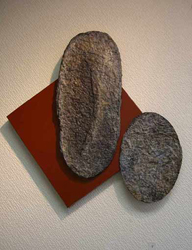Ā°WORKSĀ°

Art Works of Taeko Tomoda -----Awaking FiveSenses-----
It is said that we transmit information to our brain through eyes in everyday life. Art itself is visual. So we watch and appreciate it. But is it really true? When we watch art work, we feel something directly from the work through eyes, but at the same time we feel lots of other things, such as temperature, humidity, scent, and sound of the space surrounding it. All of them are mixed together. We get this mixed feeling through our whole body and transmit it to our brain. Feel and then think, thatĀfs the basic idea to appreciate art work, I believe. I had an opportunity to produce an exhibition in Hamburg, Germany. The theme of the exhibition I selected was ĀeArt of Five Senses----its physical expansionĀf . I thought we need to use not only our eyes but also other four senses to have deeper appreciation because lots of modern art works transform the space of its surroundings and get themselves into shape. Taeko Tomoda is an artist who thinks the sense of ĀetouchĀf is as important as the sense of ĀesightĀf. In the catalogue of her private exhibition, I found the phrase to show how she feels about the sense of ĀetouchĀf . She wrote, Āg Everything is superficial nowadays. We depend on the sense of ĀesightĀf too much. I am sorry weĀfve lost the sense of ĀetouchĀf. Āg What she wrote might be the warning to us against putting too much emphasis only on the sense of ĀesightĀf. Tomoda creates her works with tesuki washi , Japanese traditional paper of her own made and sumi, Chinese ink. I visited her exhibition and had an peculiar experience ------ I touched the surface of her work with my eyes. It might be said my sense of ĀesightĀf was directly linked with my sense of ĀetouchĀf. Lately Tomoda creates works which are floating in the air. The surface of those works sometimes looks like craters of the planet and sometimes looks like the surface of the rock. Japanese paper has a variety of surface expressions. Heavy and light, smooth and rough, soft and hard, thin and thick. Her work can be heavy and light at the same time. It is the characteristics of the Japanese paper. Tomoda knows it well and she shows those opposite ideas in each of her works fairly artistically. The material of her works, Japanese paper and Chinese ink, is a part of Japanese original culture. And it is also a part of East Asian traditional culture. It is quite natural for Tomoda, a Japanese and an Asian artist, uses Japanese paper and Chinese ink as a material of her works. They are surely our culture, our homeland, our nature and our history. So Tomoda feels very comfortable and natural to use those materials and we viewers also feel very comfortable and natural. In front of her works we remind of our traditional culture and our five senses are also stimulated and awakened.
-------------------Yoshio Kato(Independent Curator)